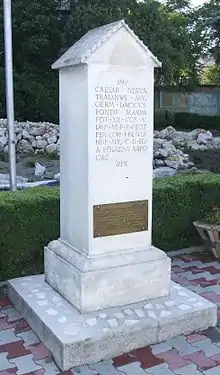Milliarium of Aiton
Milliarium of Aiton is an ancient Roman milestone (milliarium) discovered in the 1758 in Aiton commune, near Cluj-Napoca, Romania.[1] Dating from 108 AD, shortly after the Roman conquest of Dacia, the milestone shows the construction of the road from Potaissa to Napoca, by demand of the Emperor Trajan. It indicates the distance of ten thousand feet (P.M.X.) to Potaissa. This is the first epigraphical attestation of the settlements of Potaissa and Napoca in Roman Dacia.

The complete inscription is: "Imp(erator)/ Caesar Nerva/ Traianus Aug(ustus)/ Germ(anicus) Dacicus/ pontif(ex) maxim(us)/ (sic) pot(estate) XII co(n)s(ul) V/ imp(erator) VI p(ater) p(atriae) fecit/ per coh(ortem) I Fl(aviam) Vlp(iam)/ Hisp(anam) mil(liariam) c(ivium) R(omanorum) eq(uitatam)/ a Potaissa Napo/cam / m(ilia) p(assuum) X". It was recorded in the Corpus Inscriptionum Latinarum, vol. III, the 1627, Berlin, 1863.
This milliarium is an attestation of the road known to be built by Cohors I Hispanorum miliaria.[2]
A copy of this milliarium was erected in June 1993 in front of the Turda Post Office (1 Dec. 1918 Street). Another copy exists in the front of the Aiton School.
Gallery
 Modern plaque from the monument in Turda
Modern plaque from the monument in Turda Latin inscription from the milliarium
Latin inscription from the milliarium 1758 Drawing of the original milliarium
1758 Drawing of the original milliarium
See also
Notes
- Lazarovici et al. 1997, pp. 202–3 (6.2 Cluj in the Old and Ancient Epochs)
- "Archaeological Repertory of Romania. Archive Of The Vasile Parvan Institute Of Archaeology – Site Location Index". Retrieved 20 September 2014.
